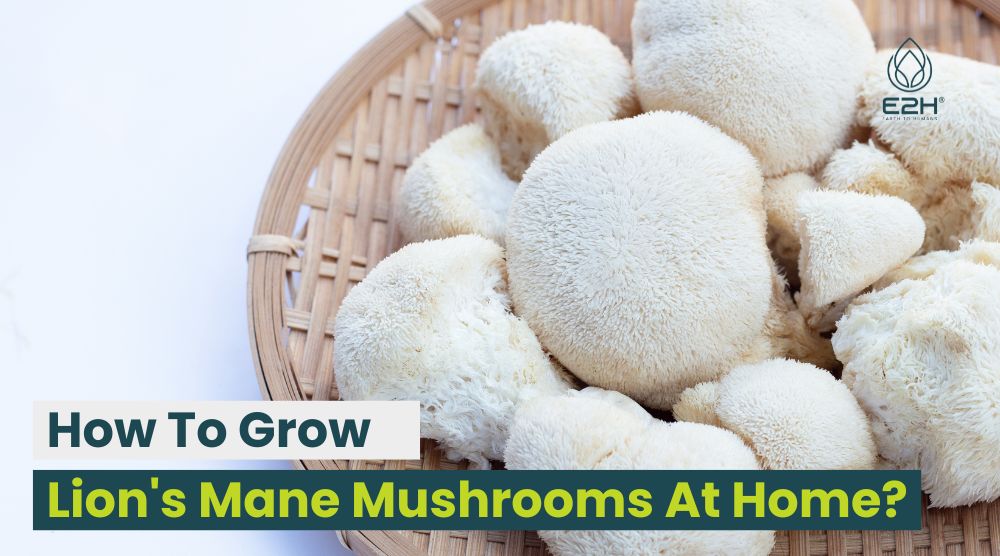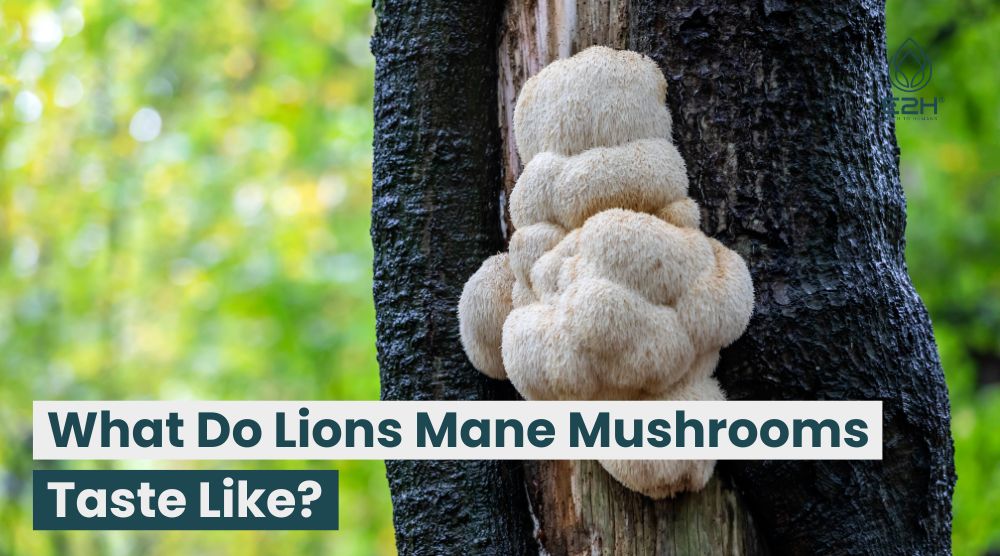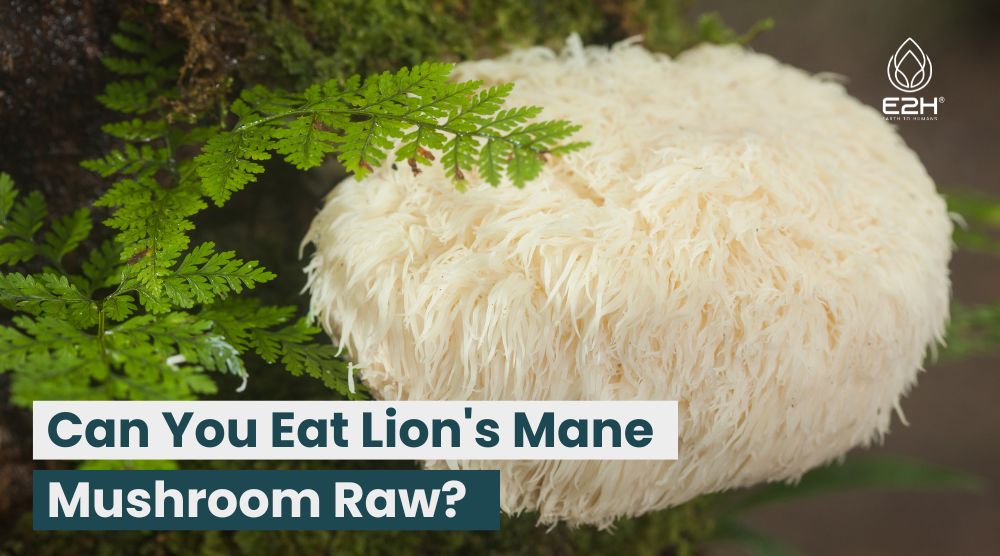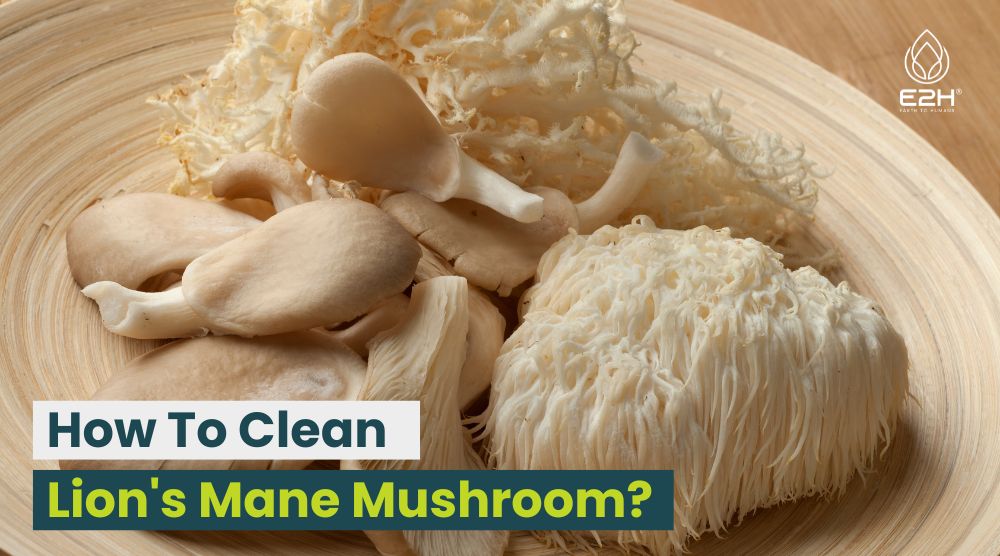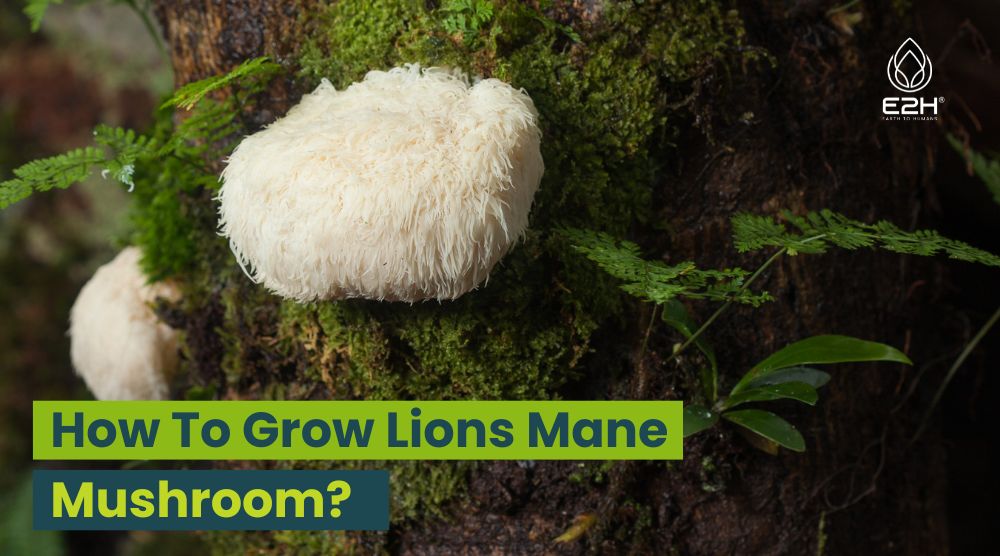How To Grow Lion’s Mane Mushrooms At Home: To grow Lion’s Mane mushrooms at home, create an ideal environment with 55-65°F (13-18°C) temperature and 85-95% humidity. Inoculate chosen medium with mushroom spawn, mist regularly, and harvest when mushrooms mature enough.
Understanding Lion’s Mane Mushrooms
Before delving into the mushroom cultivation process, it’s essential to familiarize ourselves with Lion’s Mane mushrooms. These fungi are not only unique in appearance but also offer impressive health benefits. Rich in antioxidants, beta-glucans, and nerve growth factors, Lion’s Mane mushrooms have been linked to improved cognitive function, reduced inflammation, and enhanced immune system support. By cultivating them at home, you can have a consistent supply of these nutritious mushrooms.

Setting up the Ideal Environment
Creating to grow the right environment for Lion’s Mane mushrooms is crucial for the successful cultivation. These mushrooms thrive in a temperature range of 55-65°F (13-18°C) and require humidity levels of around 85-95%. Choose a well-ventilated area away from direct sunlight to maintain the required conditions.
Choosing the Right Growing Medium
Lion’s Mane mushrooms can be cultivated on various substrates, including hardwood sawdust, straw, or even coffee grounds. Each medium has its pros and cons, so it’s essential to choose one that aligns with your resources and preferences. Hardwood sawdust is a popular choice due to its high success rate and ability to produce abundant fruiting bodies.
Sourcing Lion’s Mane Mushroom Spawn
Mushroom spawn serves as the “seed” for your mushroom cultivation. You can either purchase Lion’s Mane mushroom spawn from reputable suppliers or create your own through sterilizing and inoculating a substrate with mushroom mycelium. Buying from trusted sources is recommended for beginners.
Preparing the Growing Area
Prepare the growing area by thoroughly cleaning and sanitizing all equipment and surfaces. Maintain a clean environment to minimize the risk of contamination. Use gloves and follow good hygiene practices during the preparation process.
Inoculation Process
Inoculation is the process of introducing mushroom spawn and liquid culture to the chosen growing medium. Follow the specific guidelines provided with your purchased grain spawn or follow reliable resources for creating your own. This step is critical for the proper colonization of the mushroom substrate grain spawn and liquid culture itself.
Caring for Lion’s Mane Mushrooms
Lion’s Mane mushrooms require regular misting to maintain the desired humidity levels. Avoid over-watering, as excessive moisture can lead to contamination. Monitor the temperature and make necessary adjustments to ensure optimal mushroom growth.
Harvesting Lion’s Mane Mushrooms
Harvesting should be done when the mushrooms reach their full size and before they start to deteriorate. Carefully cut or twist the mushrooms from the substrate, leaving some behind to allow for future flushes growing mushrooms. Proper harvesting encourages the growth of more mushrooms.
Troubleshooting Common Issues
While cultivating Lion’s Mane mushrooms can be a relatively straightforward process, some common issues may arise. These include contamination, low fruiting rates, and slow mycelium growth. Understanding and addressing these problems promptly will help ensure a successful harvest.
Benefits of Growing Lion’s Mane Mushrooms
Growing Lion’s Mane mushrooms at home has several advantages.
- Firstly, you have full control over the fresh, whole, lion’s mane mushroom mushrooms grow, mushroom grow itself, mushroom growing bags and process, ensuring that no harmful chemicals or pesticides are used.
- Secondly, freshly harvested fresh harvest lion’s mane mushroom your own lion’s mane mushrooms grow offer superior taste and nutritional value compared to store-bought varieties that may have been sitting for days.
- Lastly, cultivating these own grow lion’s mane mushroom mushrooms, can be a therapeutic and satisfying hobby, connecting you with nature and the wonders of mycology.
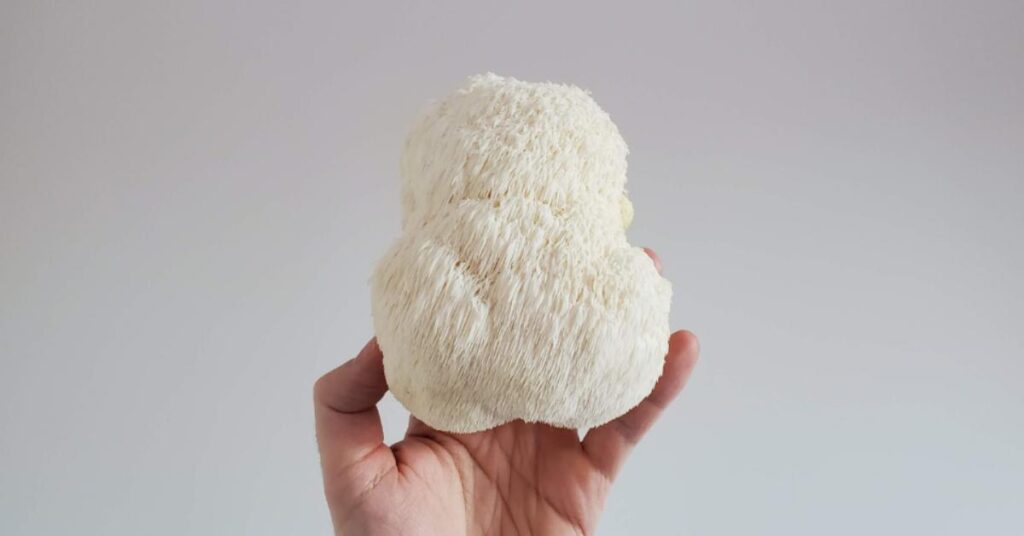
Delicious Lion’s Mane Recipes
Once you have a bountiful harvest of fresh, Lion’s mane grow mushroom and Mane mushrooms, the culinary possibilities are endless. Explore delectable recipes such as this: Lion’s mane mushrooms grow and mushroom Mane stir-fry, wild lion’s mane mushrooms, lion’s mane mushroom and risotto, or even fresh Lion’s mane mushrooms and the lions mane mushroom Mane “crab” cakes. These delicious harvest lion’s mane mushrooms have a delicate seafood-like flavor that can elevate any dish.
Storing and Preserving Lion’s Mane Mushrooms
If you have more mushrooms than you can consume immediately, it’s crucial to store and preserve them correctly. Proper storage ensures they retain their flavor and nutritional value. Freezing, drying, or pickling are popular preservation methods.
Health and Safety Considerations
While Lion’s Mane mushrooms are generally safe for consumption, it’s essential to be cautious and avoid misidentification with any wild and potentially toxic mushroom species. Additionally, if you have any allergies or medical conditions, consult a healthcare professional before adding Lion’s Mane mushrooms to your diet.
How long does it take to grow Lion’s Mane at home?
Growing Lion’s Mane mushrooms at home requires patience, as it typically takes 4 to 6 weeks from the inoculation stage to achieve a full harvest. The mycelium needs time to colonize the substrate and develop fruiting bodies. Consistent care and ideal environmental conditions are crucial during this period of up to six years to ensure healthy growth and a bountiful yield of this unique and nutritious mushroom.
Is Lion’s Mane mushroom hard to grow?
While not overly challenging, cultivating Lion’s Mane mushrooms does require attention to detail. Beginners may face some difficulties, but with proper research and understanding of the medicinal mushroom growing process, it becomes more manageable. The key lies in maintaining the correct humidity, temperature, and a clean growing environment. Sourcing quality mushroom spawn and selecting a suitable growing medium are essential for success. As with any new endeavor, practice and learning from experiences will lead to improved mushroom cultivation outcomes.
What are the conditions for Lion’s Mane mushrooms to grow?
Lion’s Mane mushrooms thrive in specific environmental conditions. They require a temperature range of 55-65°F (13-18°C) and high humidity levels between 85-95%. The growing area should be well-ventilated and away from direct sunlight. Creating an ideal environment is critical for the mycelium to colonize the substrate effectively and for the fruiting bodies to develop properly. Regular misting to maintain humidity and careful monitoring of the temperature are vital for successful cultivation.
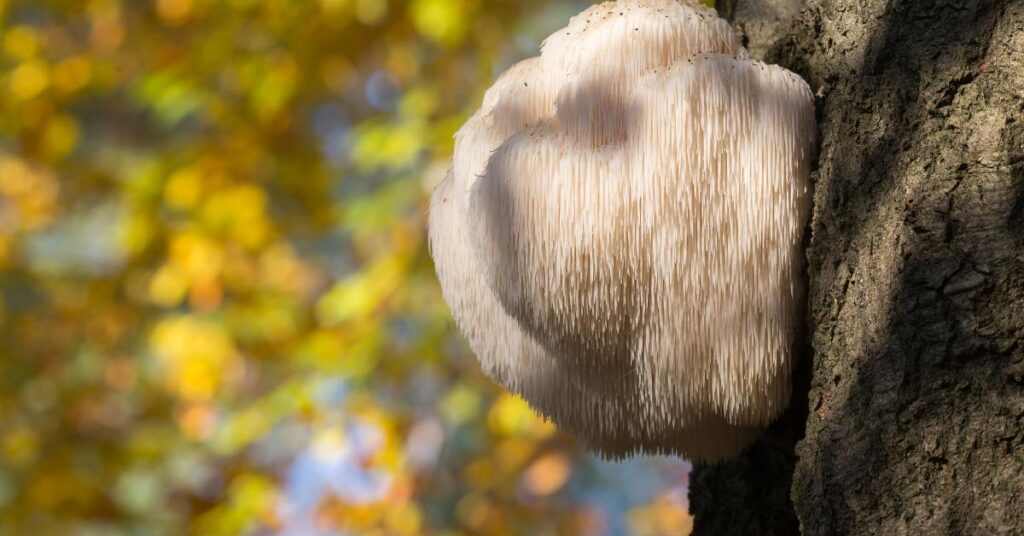
What is the best way to grow Lion’s Mane mushrooms?
The best way to grow Lion’s Mane mushrooms is to follow a systematic approach. Start by selecting a suitable growing medium, such as hardwood sawdust or straw, and ensure it is properly prepared and sterilized. Purchase high-quality Lion’s Mane mushroom spawn from reputable suppliers or create your own through sterilization and inoculation.
Maintain a clean and controlled environment, providing the necessary humidity and temperature levels. Regularly mist the growing area, and be patient as the mycelium colonizes the substrate. Harvest the mushrooms when they reach full size but before deterioration. With attention to detail and care, you can achieve a successful harvest of Lion’s Mane mushrooms at home.
How to Grow Lion’s Mane Mushroom From Start to Finish
FAQs
How long does it take for Lion’s Mane mushrooms to grow?
Lion’s Mane mushrooms typically take 4 to 6 weeks to fully mature from the inoculation stage.
Can I grow Lion’s Mane mushrooms indoors?
Absolutely! Lion’s Mane mushrooms can be grown indoors as long as the environmental conditions are met.
Is it safe to eat Lion’s Mane mushrooms raw?
While it’s safe for most people to grow mushrooms, cooking Lion’s Mane mushrooms is recommended to enhance their flavor and digestibility.
Can I use a mushroom kit to grow Lion’s Mane mushrooms?
Yes, there are mushroom kits available that make it easier to grow Lion’s Mane mushrooms, especially for beginners.
Can I compost the substrate after harvesting?
Yes, the spent substrate can be added to your compost pile, contributing to the overall sustainability of your gardening efforts.
Conclusion
Growing Lion’s Mane mushrooms at home can be a fascinating and rewarding endeavor. From understanding mushroom fruits and their benefits and creating an ideal growing environment to harvesting and preserving the mushrooms, each step brings you closer to the world of mycology. Embrace the mushroom growing journey, and with patience and care, you’ll enjoy a constant supply of these marvelous and nutritious mushrooms.
